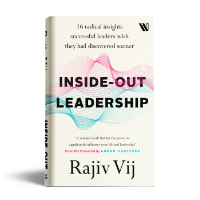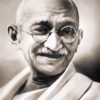One fish said to the other, “Do you believe in this ocean that they talk about?” So goes an ancient Chinese saying and I think it well illustrates how narrow our vision of the world and the universe can be. We see the world from our limited perceptual framework. Despite an overwhelming evolution of the human race, an average human mind is severely restricted by what it can perceive through the senses. What we can hear is limited by the frequencies our ears can process; dogs can hear many higher frequencies and hence have a very different perception of the sounds out there. Our sight is limited by the light frequencies our eyes can relate to; since pit vipers can sense heat from infrared rays (like night vision goggles), they must view the same world very differently. If we had a different receiver mechanism, we would be hearing other frequencies and seeing differently. From our knowledge of science, we know so many things are just not what they appear – earth is not flat, the ground below us is not stationery; the sun doesn’t rise in the east and doesn’t set in the west.
The fact is we are seeing and hearing what we can and not what the reality is. The world out there is an unprocessed and formless data, waiting to be interpreted by us. The human nervous system takes in only the minutest proportion, less than one part per billion, of the total energy vibrating in the environment. As Marshall Glickman describes, “Research shows that each conscious moment is actually comprised of many much smaller and unconscious “mini” moments, each appearing and disappearing rapidly.” According to Buddhist texts, it takes 17 mind-moments for a cognitive experience to register. As this happens real quickly, we register uninterrupted awareness – no different from a movie that seems continuous even though it’s made of several rapidly flashed still photos. We are so engrossed in this fascinating movie that we are unable to step aside to distinguish between the movie and the reality.
Besides the limitation in our ability to pick up the absolute truth in the first place, our perceptions are further clouded by our own thoughts and emotions. It is believed that 20% of what we see is objective data and the rest is a projection biased by our thoughts and emotions. Neuroscientists highlight that the electrical impulses that reach our retina, to enable us to “see”, must also interact with both the thinking and the emotional part of the brain. We thus don’t see a mosaic of blue, white and colorless space, but sky and clouds. As French author, Anais Nin said, “We do not see things as they are. We see them as we are” – our thoughts and emotions project their own hues and colors to whatever we observe.
What appears solid may not be. As we gain deeper insight, we learn that the smallest units of energy are just in free flow thought it all. What appears solid is only so because of the frequency of wavelengths that our senses are capable of perceiving. We create a three-dimensional world from what is a continuum of free flowing energy, comprising of electrons and neutrons. Like the fish in the above saying, when we cannot see this continuum, we notice the separate parts of the creation – the trees, the animals, the objects – as disjointed from us, which in turn make us feel separate from the whole. The question is would a tree falling in a forest make any sound, if there was no one to hear it? As an eminent British neurologist said, “I want you to realize that there is no color in the natural world and no sound – nothing of this kind; no textures, no patterns, no beauty, no scent.” It’s our presence and perception that gives way to the formation of reality as observed by us.
What is the truth then and how do we experience it? The powerful thing is that among all the living beings, humans alone have the ability to comprehend and experience this reality and that’s what makes the human life so precious. We can get initiated into grasping this reality by starting to reach out to our inner awareness. This inner awareness is not the mind, or our thoughts; it’s the consciousness which allows us to observe the mind, and our thoughts and emotions. It’s this awareness which allows us to remember parts of a dream even when we are asleep. If we close our eyes and just focus on the thoughts that arise in our mind, it’s the inner awareness which allows us to notice these thought patterns. While it’s easy for us to initially get swept away by the thought patterns and not be able to observe steadily, with practice, we can begin to recognize the observer as distinct from the thinker and the actor. We can then learn to see that this awareness is like a mirror – it only reflects what the mind is going through, without any projections of its own. The mirror has no worries, fears, anger or cravings – its pure awareness, pure consciousness. All the thoughts and accompanying emotions arise in the mind, even though we experience them only through this awareness.
This observer, the inner awareness, is who we really are. In our normal life, we are so busy with external stimulus that we lose connection with our true selves. As we become more conscious of this awareness, we begin to get closer to understanding our own reality – which in turn allows us to better comprehend the truth out there. Meditation can be greatly helpful in building deeper clarity as well. When we feel connected to this inner awareness, we realize that this awareness (and hence our true self) is never born, never dies; it’s vast and is in no way limited to time and space and so forth. We can then start to comprehend that this awareness is omnipresent, and governs everything; all of us are made of it and are not discreet individuals but just parts of a continuum of awareness. It’s similar to knowing that God is in each one of us, and we are part of the same whole – and the knowledge of this ultimate truth can set us free. Interestingly, this does not take us away from the regular worldly life but infact helps us to lead it with much greater joy and fulfillment. As we make a conscious effort to stay connected with our inner awareness and our true selves, we become better equipped to playing the roles of our life – businessman, doctor, husband, father, friend etc. – all with tremendous happiness and peace within. Yet, it aids us in not getting so identified with these roles that we lose sight of the reality or get directly impacted by every little pleasant or unpleasant event related to these roles. This knowledge facilitates us to be like an actor who plays his role on stage with great sincerity but stays conscious through the entire drama that he is really not the character he’s playing – and thus not overly identify with the fortunes and misfortunes of the dramatis personae.











 Change is Coming to Planet Earth…
Change is Coming to Planet Earth… Stop Judging, Start Loving!
Stop Judging, Start Loving! Mahatma Gandhi Revisited: Life Lessons For You And Me
Mahatma Gandhi Revisited: Life Lessons For You And Me The Bane Of Modern Society: Excessive Individualism
The Bane Of Modern Society: Excessive Individualism
your very well written article brought to mind the movie ‘phenomenon’ which stars john travolta. it has a scene which i have not been able to forget. travolta has an apple in his hand from which he’s taken a bite. he uses the apple to say that no matter what, the energy of an apple is never lost. if left uneaten or if it just falls to the ground, an apple will rot and decay. the energy goes back to earth to form a new apple perhaps or just enrich that peice of soil. but if you took a bite out of it, the energy of the apple would become a part of you, and you could carry it with you forever.
like you have said, matter just exists and human perception of matter is limited by the sensory organs at one level; our past experiences, memory and analytical skills at another level.
Great insight Usha, thanks for sharing!!